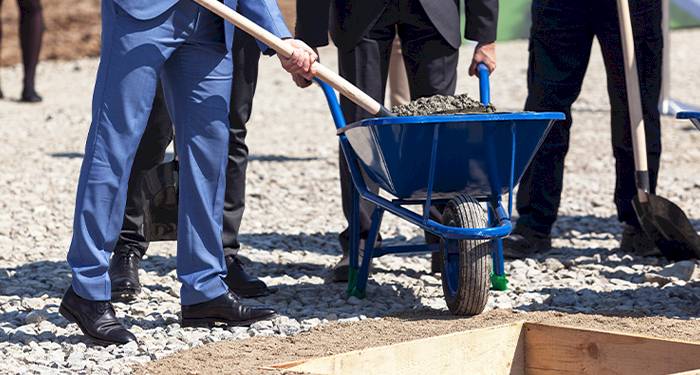Lawn Treatment Service Cost
- The average lawn treatment cost is around £45.
- Treating a lawn typically takes around 30 minutes to finish.
- A complete pricing breakdown which includes cost factors to consider, types of treatments, along with what such a task usually involves.
- How long the job should approximately take and a general overview of what kind of jobs can be performed.
- How to find and hire a gardener.
Want to know how much treating a lawn costs?
In this guide, you'll learn about all the costs associated with treating a lawn in the UK. We'll cover the cost for treating different types of grass, material costs if you're thinking of doing it yourself, as well as additional costs you might need to budget for.
In 2025, average lawn treatment service costs you should expect to be quoted by a tradesperson are around £45.
Ready to get a quote for a lawn care?
We have a range of local gardeners ready to offer you a free quote!
Want to find out more first?
Get the full scoop on lawn care costs in our guide below!

£45
Table of Contents
How Much Does Lawn Care Cost?
Usually, gardeners and lawn care specialists will offer some type of monthly or annual package to their customers, saving you money and guaranteeing them business. Regular treatment is the key to maintaining a luscious lawn.
A simple way to calculate the cost of treating your lawn on a one-time basis is by knowing the average cost per m², which is around £0.21.

Although this may vary slightly, working this out will give you a rough idea of what you will be charged. You can clarify this with your gardener before they begin the job.
The cost will (as always) depend on the gardener’s fees. However, prices will vary depending on the type of treatment, the size and the condition of your lawn. Before they begin, the gardener will be able to clarify treatments and costs with you.
How can I quickly kill off my lawn to lay a new one?
Lawn Care Prices
It can be difficult to work out how to give your lawn the best care as well as to pay the best price for the lawn treatments.
Below is a table summarising the prices you can expect to pay for common treatment packages or subscriptions.
| Type of treatment | Cost Range | Average cost |
|---|---|---|
| One off treatment | £30 – £60 | £45 |
| Monthly lawn care cost | £11 – £17 | £14 |
| Full lawn care service (yearly) | £75 – £150 | £100 |
| Seasonal treatments (per visit) | £15 (50m lawn) – £120 (1,000m lawn) | £67.50 |
| Lawn fertiliser treatment (per quarter) | £20 – £30 | £25 |
| Lawn care cost per m² | £0.12 – £0.30 | £0.21 |
The type of treatment your lawn receives can also affect the cost. Below is a table summarising the average price ranges for common treatments that your lawn may require, priced on a one-time treatment.
| Treatment Type | Average Cost |
|---|---|
| Scarification | £45 – £120 |
| Aeration | £30 – £80 |
| Overseeding | £60 – £160 |
| Topdressing | £80 – £180 |
| Systematic fungicide | £45 – £120 |
| Contact fungicide | £45 – £120 |
| Nematodes (pest control) | £35 – £85 |
| Slowmow | £15 – £45 |
Seasonal treatments are a popular option to keep your lawn looking fresh all year round. Below is a table outlining the expected price ranges of seasonal treatments for different sized areas of grass.
| Treatment Type | Size of Lawn | Average Cost |
|---|---|---|
| Seasonal Treatment | 50m² | £15 – £18 |
| 80m² | £20 – £23 | |
| 130m² | £25 – £28 | |
| 170m² | £30 – £35 | |
| 240m² | £40 – £45 |
My new lawn is patchy with areas where the grass isn't growing. How can I fix it?
Supply Only Costs
There is always the option of providing the gardener with your own supplies, potentially reducing the labour costs, or simply using these supplies yourself and treating your own lawn.
| Treatment | Frequency | Cost of Product |
|---|---|---|
| Lawn feed | Per treatment | £5 – £21 |
| Pest control (Nematodes) | Per treatment | £20 – £45 |
| Lawn scarifier | One-off purchase | £30 – £60 |
| Lawn aerator | One-off purchase | £8 – £45 |
Additional Costs
Garden Maintenance
This can be difficult to fit into a busy schedule and may often slip your mind. Hiring a professional to upkeep your garden maintenance could be perfect for anyone lacking in spare time or who does not have a green thumb.

Costs start from around £15 an hour and can involve as much or as little work as you see fit to keep your garden up to standard.
Patio Cleaning
Patio Cleaning is another excellent way of visually improving your garden. It is a simple task that can be done yourself or by a professional, usually depending on whether you prefer to pay for the pressure washer or the service.
Rates usually fall between £150 and £400 depending on the size of the patio and the amount of dirt needing to be removed.
Tree Stump Removal
This is an excellent way to invest in your garden, preventing issues with your lawn, paving stones and any other plants you may have.
It can be as cheap as £40 to have a tree stump removed, but it will depend on a variety of factors, including the size, type of tree and removal method.
Flower Beds and Plants
This can contribute to the beauty of your garden and can be easily planted yourself. Plants and flowers come in a wide range of prices, so the types that you choose will heavily depend on your budget and desired ease of maintenance.

Labour Costs and Timescales
Usually, gardeners and specialists will charge one inclusive price for both the labour and the products they will use. The lawn service treatment cost can vary, but usually falls between £15 to £50 per hour, often depending on the type of treatment.
The time frame for a single treatment will depend on many factors, such as the size and condition of your lawn as well as the type of treatment it requires. Smaller jobs will start from taking around 30 minutes but can also be upwards of 4 hours for bigger and more complicated courses of treatment.

Factors such as weather conditions or misdiagnosis of the lawn’s condition can change the time frame in which it takes the gardener to complete the lawn treatment.
Cost Factors of Treating a Lawn
Type of Treatment
Some treatments are more expensive to supply or are more time-consuming to apply than others.
Lawn Condition
Lawns that begin in worse condition may need more intensive treatment and could take up more time and product, increasing the cost.
Lawn Size
Larger areas of lawn will take up more product and a longer time to apply the treatment compared to smaller areas.
Number of Treatments Needed
Some lawns may require multiple treatments to tackle any problems.

Location
Where you live within the UK can alter the prices of gardening products as well as rates of labour.
Labour Costs
Gardeners and businesses can create their own rates and costs for their services, and so prices of lawn treatment services will vary.
How do you prep ground for grass seed?
What's Involved in Treating a Lawn?
With there being multiple types of lawn treatment, there are different methods of application.
Some treatments are applied by being sprayed onto the lawn, focusing specifically on the desired areas. These include treatments such as lawn feed and fungicides.
It is recommended that after these treatments are applied, you should not water your lawn, as this may affect the penetration of the products into the grass.
Nematodes are also sprayed onto the lawn, but different to other spray-on treatments, it is recommended to water the lawn before application, as this allows them to better absorb into the soil.
Manual jobs include scarification and aeration, which involve using specialist equipment to break up and revitalise your lawn. These methods can become messy, and clean-up of soil will likely be required afterwards.
Topdressing is also a manual method of lawn treatment, involving the layering of compost over the lawn to provide it with nutrients that are beneficial to its growth.
This is followed by raking the compost into the ground to ensure the grass receives the nutrients.
Can I Treat a Lawn Myself?
Lawn treatments are often easy to do yourself, with many products being widely available in gardening centres and online. However, hiring a professional can be useful if you are uncertain what type of treatment your lawn requires or if you do not feel confident in applying the treatments yourself.
One of the easiest methods to treat your lawn yourself is scarification. Lawn scarifiers can be both mechanical and manual, with mechanical devices starting at an average of £60 and manual ones costing around £30.
Alternatively, you could check local gardening groups and pages for equipment to borrow or rent, saving you the cost of buying equipment you only intend on using once.
However, the cheapest method of lawn scarification is to use a rake, which can cost only £10. A rake is best used for surface-level treatments and on ground that is not too dense, as it can be a struggle to penetrate lower layers of soil.
Aeration is also a simple method for DIY lawn treatment and can be easily performed using lawn aeration shoes or an aerator fork. Lawn aeration shoes can cost between £8 and £30 and aerator forks around £15 to £45, which are both available from most gardening centres.
Are different rakes necessary for the lawn, or is there one that's suitable for all maintenance jobs?
So although once raked it may look a little bare, it is ultimately for the greater good — which in this instance would be a lush, green space."

Lawn feed is a common form of DIY lawn treatment and is widely available from garden centres and supermarkets, starting from as little as £4. Although it is easily applied, better results may be seen when performed by a professional, using their higher standard solution, which tends to be stronger and can be tailored to more specific needs of your lawn.
Pesticides and fungicides can be purchased from gardening centres for around £30 and do not require professional application. However, it is the user’s responsibility to ensure that the product is used in the correct quantities and in accordance with health and safety laws.
If you feel unsure or uncomfortable using these products, it may be better to consult a professional who will be able to apply a product that they know is safe and will meet the needs of your lawn.
It is also worth considering using environmentally friendly alternatives, as pesticides and fungicides can be very damaging to the environment and potentially to the rest of your garden.
It is important to remember that professional-grade treatments and applications are often much more successful and effective than store-bought, self-applied treatments. This is due to the fact that some treatments require a licence to access the product, as strong chemicals can be dangerous without proper handling.
Types of Lawn Treatments
Here are a few types of different lawn treatments you can have:
Watering
Perhaps the most obvious treatment, watering your lawn, can solve most simple problems. The average lawn requires one inch of water per week, so be sure to monitor the rainfall alongside your watering levels.
You can do this with a rain gauge, which will help you decide whether to water your lawn or not. One way to know if your lawn needs watering is if footprints are left behind after being walked over.
Fertiliser
Fertiliser is essentially food for your lawn, encouraging it to grow strong and vibrant. Different fertilisers suit different issues and should be applied at different times of the year, so it is important to read the labels carefully.
- If your grass has bare patches, use a fertiliser that is high in phosphorus content, as this will encourage root development.
- If your grass is extremely dry, use fertiliser that is high in potassium, as this will improve tolerance to disease and drought.
- If you want a thick, healthy lawn, use a fertiliser that is rich in nitrogen, encouraging growth and greener grass.
This tends to be the most popular spring lawn treatment.
Aeration and Scarification
Harsh winters and heavy usage can leave a lawn looking flat and tired due to the compacted soil and thatch that forms over the surface. Evidence of this is dead patches of grass, as pathways for water and nutrients are blocked, and the roots become parched.
Methods such as aeration and scarification can help create new pathways for these elements to reach the roots and promote growth and regeneration.
This tends to be the most popular autumn lawn treatment.
Pre-emergent and targeted weed control
Preventing weeds from growing helps maintain the health of your lawn. Having a thick, healthy lawn is the best and most simple way to achieve this, making it harder for weeds to grow.
If you are concerned that this is not enough for your lawn, you can use pre-emergent herbicides to prevent them before they even begin to appear. However, if weeds have already begun to grow, you can use herbicides to get rid of them.

It is worth considering using natural remedies and weed killers rather than chemical solutions, as they are far better for the health of your grass and the environment in general.
In order to be able to banish weeds from your lawn, you will need to know:
- The type of weed you are trying to eliminate
- When they grow (to be able to stop them before they start)
- How to get rid of them
What is a cheap way of removing dandelions from your lawn?
Pesticide Regulations
There are multiple laws and regulations surrounding the use of garden pesticides and Plant Protection Products that limit their usage and regulate who is able to purchase and apply them.
Pesticides and PPPs often contain hazardous chemicals which must be stored and applied properly in order to sustain the safety of others. Professionals using certain pesticides must have a qualification in their usage and evidence of appropriate training.
Anyone using pesticides will also have a responsibility to take precautions in accordance with HSE guidelines.

Pesticides that are designed for domestic use do not require the user to have a certificate, but they do have a responsibility to follow guidelines and instructions carefully – failure to do this can result in persecution.
It is recommended to use organic pesticides over chemical ones, which are far more environmentally friendly and pose less risk to the user.
These regulations can be intimidating, and so if you are unsure how best to follow them or do not feel confident with using pesticide products, hiring a professional may be the best option for you.
Hiring Contractors to Treat a Lawn Checklist
Here is what to look for when hiring a tradesperson to treat your lawn:
Do They Have the Correct Certification?
For example, ask for any licenses they may need to use certain products or machinery.
Ratings
Reading reviews of their previous work, making sure that customers were satisfied and that their treatments were performed in accordance with pesticide guidelines.
Look at Their Previous Work
Perhaps on their website or attached to customer reviews, there will be images of the contractor’s previous work. You will be able to see if there is a significant change and whether the employers are happy with the result.
FAQs
What is Revive Lawn Treatment?
Revive Lawn Treatment is a natural soil treatment made from organic materials and perfect for dried-out lawns. Here are the benefits:
- Aids water penetration - Revive has a special "wetting agent" that helps hydrate hard-to-wet soil.
- Helps essential nutrients "break free" from the soil for absorption - Acting as a "chelating agent", Revive stops iron and zinc from getting locked up in the soil, making them available for plants and roots to absorb to promote healthy grass growth.
What is the best lawn treatment?
The best lawn treatment depends on your lawn issues, but a balanced approach would be to ensure your grass is mown regularly to promote healthy growth and to ward off weed growth, as well as being well-watered.
If you have issues with a patchy lawn, you should overseed and fill in patches with new grass seed, and if you have trouble with your soil, you can consider a lawn treatment like Revive to mitigate moisture issues.
I applied my own lawn treatment, but I have not seen any improvements. Why?
Lawn improvement is not instant, and it can take time to see results - anywhere from 1 to 8 weeks, depending on your treatment.
If you've tried some DIY methods and still haven't seen any difference after a few months, you could consider hiring a gardener to get their specialised advice.
Is it a good idea to treat my own lawn?
If you know the exact problem with your lawn, there are lots of products available to help you treat your own lawn. However, you should make sure you know your exact grass problem before starting new treatments, as improper care can lead to bigger problems.
If you're unsure about your exact lawn issues, contact a professional gardener for their advice.
How can I keep my lawn healthy?
Here are some tips to keep your lawn at optimal health:
- Regularly mow your lawn to promote root spread and lessen weed growth, keeping it at around 3 inches high. Make sure you don't cut more than 1/3 of the length off in any mow.
- Keep your lawn hydrated by watering it. This is best done in the morning before the sun rises to ensure your lawn absorbs the moisture rather than it being evaporated by the sun.
- Fertilise your lawn to help fill in any gaps, and aerate with an aeration tool to help root nutrient absorption.
- Remove weeds when you see them, and remove the layer of thatch (around half an inch of dead grass on top of your lawn) to ensure water and nutrients get to the soil and roots.
Is it safe for my children and pets to use the lawn after the treatment?
You should always check your lawn treatment instructions, as there will be different timelines for each product. If you've used a chemical-based lawn treatment, you're likely to need to wait for a longer period than if you've used an organic treatment.
Sources
https://www.hse.gov.uk/pesticides/using-pesticides/codes-of-practice/code-of-practice-for-using-plant-protection-products.htm
https://www.hse.gov.uk/pesticides/resources/R/Recognised_certificates.pdf
https://www.gov.uk/find-licences/pesticide-approval
https://www.gov.uk/government/publications/pesticides-uk-national-action-plan
https://garden-care.org.uk/









